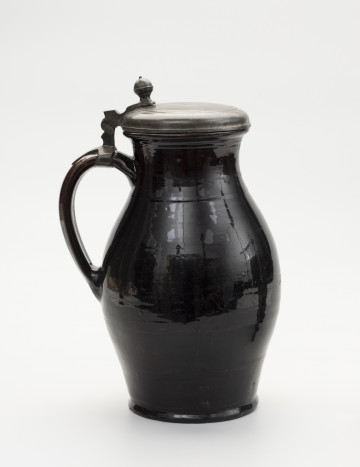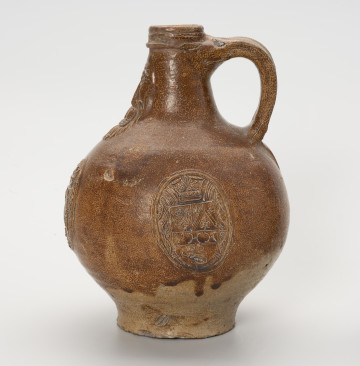
Jug with a lid
1850 — 1900
National Museum in Szczecin
Part of the collections: Material culture of West Pomerania, Folk ceramics
Beer, which requires a combination of barley and hops, has been consumed for some 6,000 years. Throughout this time, this sparkling, bitter and refreshing beverage was drunk from vessels made of clay and stoneware, buffalo horn, leather, wood, silver, tin, bronze, porcelain, and finally, glass. Their shape also underwent a metamorphosis: simple bowls turned into goblets and tankards fitted with handles, lids, and legs. They were also decorated in a variety of ways, including engraving, paintings, silvering, or gilding. Nowadays, lager is mainly served in glasses or other glassware. The last of the stoneware, tin, and silver tankards, which were still popular at the beginning of the 20th century, have now disappeared from renowned beer houses. Today, these vintage and sometimes beautifully decorated tankards are on display in museums. One of these is the vessel on display, which was made in the first half of the 19th century, probably in a pottery workshop in or near Pasewalk, in north-eastern Germany. The tankard features a lid intended to protect the lager flavour from the harmful effects of air and to maintain the right temperature, as it was common to drink heated beer in the past. Also aiding in this task is the material from which the tankard was made, that is, stoneware, a type of low-absorbent ceramic with a highly frothy top. In addition, it protects the beer from light, which the beverage should absolutely not be exposed to. The inside of the tankard is covered with enamel, contributing, according to past connoisseurs, to keeping the beer head beautifully foamy. Its shape, delicate ornamental motifs, slender handle that fits comfortably in the hand, and overall proportions make it an aesthetically pleasing and handy vessel for discovering all the flavour benefits of the amber drink. Iwona Karwowska
Author / creator
Object type
stein, tankard
Technique
throwing (pottery technique), garnarska
Material
stoneware, glazing, email
Origin / acquisition method
acquisition
Creation time / dating
Creation / finding place
Owner
Muzeum Narodowe w Szczecinie
Identification number
Location / status

1850 — 1900
National Museum in Szczecin

1600 — 1699
National Museum in Szczecin

after 1894 — 1945
National Museum in Szczecin
DISCOVER this TOPIC
Castle Museum in Łańcut
DISCOVER this PATH
Educational path